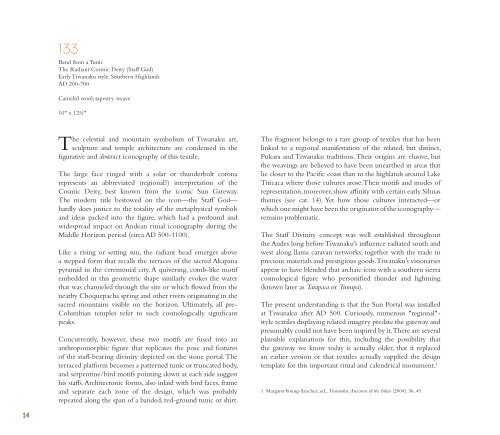You also want an ePaper? Increase the reach of your titles
YUMPU automatically turns print PDFs into web optimized ePapers that Google loves.
133<br />
Band from a Tunic<br />
The Radiant Cosmic Deity (Staff God)<br />
Early Tiwanaku style, Sou<strong>the</strong>rn Highlands<br />
AD 200-700<br />
Camelid wool; tapestry weave<br />
10" x 12½"<br />
The celestial and mountain symbolism of Tiwanaku art,<br />
sculpture and temple architecture are condensed in <strong>the</strong><br />
figurative and abstract iconography of this textile.<br />
The large face ringed with a solar or thunderbolt corona<br />
represents an abbreviated (regional?) interpretation of <strong>the</strong><br />
Cosmic Deity, best known from <strong>the</strong> iconic Sun Gateway.<br />
The modern title bestowed on <strong>the</strong> icon—<strong>the</strong> Staff God—<br />
hardly does justice to <strong>the</strong> totality of <strong>the</strong> metaphysical symbols<br />
and ideas packed into <strong>the</strong> figure, which had a profound and<br />
widespread impact on Andean ritual iconography during <strong>the</strong><br />
Middle Horizon period (circa AD 500-1100).<br />
Like a rising or setting sun, <strong>the</strong> radiant head emerges above<br />
a stepped form that recalls <strong>the</strong> terraces of <strong>the</strong> sacred Akapana<br />
pyramid in <strong>the</strong> ceremonial city. A quivering, comb-like motif<br />
embedded in this geometric shape similarly evokes <strong>the</strong> water<br />
that was channeled through <strong>the</strong> site or which flowed from <strong>the</strong><br />
nearby Choquepacha spring and o<strong>the</strong>r rivers originating in <strong>the</strong><br />
sacred mountains visible on <strong>the</strong> horizon. Ultimately, all pre-<br />
Columbian temples refer to such cosmologically significant<br />
peaks.<br />
Concurrently, however, <strong>the</strong>se two motifs are fused into an<br />
anthropomorphic figure that replicates <strong>the</strong> pose and features<br />
of <strong>the</strong> staff-bearing divinity depicted on <strong>the</strong> stone portal. The<br />
terraced platform becomes a patterned tunic or truncated body,<br />
and serpentine/bird motifs pointing down at each side suggest<br />
his staffs. Architectonic forms, also inlaid with bird faces, frame<br />
and separate each zone of <strong>the</strong> design, which was probably<br />
repeated along <strong>the</strong> span of a banded, red-ground tunic or shirt.<br />
The fragment belongs to a rare group of textiles that has been<br />
linked to a regional manifestation of <strong>the</strong> related, but distinct,<br />
Pukara and Tiwanaku traditions. Their origins are elusive, but<br />
<strong>the</strong> weavings are believed to have been unear<strong>the</strong>d in areas that<br />
lie closer to <strong>the</strong> Pacific coast than to <strong>the</strong> highlands around Lake<br />
Titicaca where those cultures arose. Their motifs and modes of<br />
representation, moreover, show affinity with certain early Sihuas<br />
<strong>the</strong>mes (see cat. 14). Yet how those cultures interacted—or<br />
which one might have been <strong>the</strong> originator of <strong>the</strong> iconography—<br />
remains problematic.<br />
The Staff Divinity concept was well established throughout<br />
<strong>the</strong> <strong>Andes</strong> long before Tiwanaku’s influence radiated south and<br />
west along llama caravan networks, toge<strong>the</strong>r with <strong>the</strong> trade in<br />
precious materials and prestigious goods. Tiwanaku’s visionaries<br />
appear to have blended that archaic icon with a sou<strong>the</strong>rn sierra<br />
cosmological figure who personified thunder and lightning<br />
(known later as Tarapaca or Tunupa).<br />
The present understanding is that <strong>the</strong> Sun Portal was installed<br />
at Tiwanaku after AD 500. Curiously, numerous "regional"-<br />
style textiles displaying related imagery predate <strong>the</strong> gateway and<br />
presumably could not have been inspired by it. There are several<br />
plausible explanations for this, including <strong>the</strong> possibility that<br />
<strong>the</strong> gateway we know today is actually older, that it replaced<br />
an earlier version or that textiles actually supplied <strong>the</strong> design<br />
template for this important ritual and calendrical monument. 1<br />
1 Margaret Young-Sanchez, ed., Tiwanaku: Ancestors of <strong>the</strong> Inkas (2004): 36, 49.<br />
14







